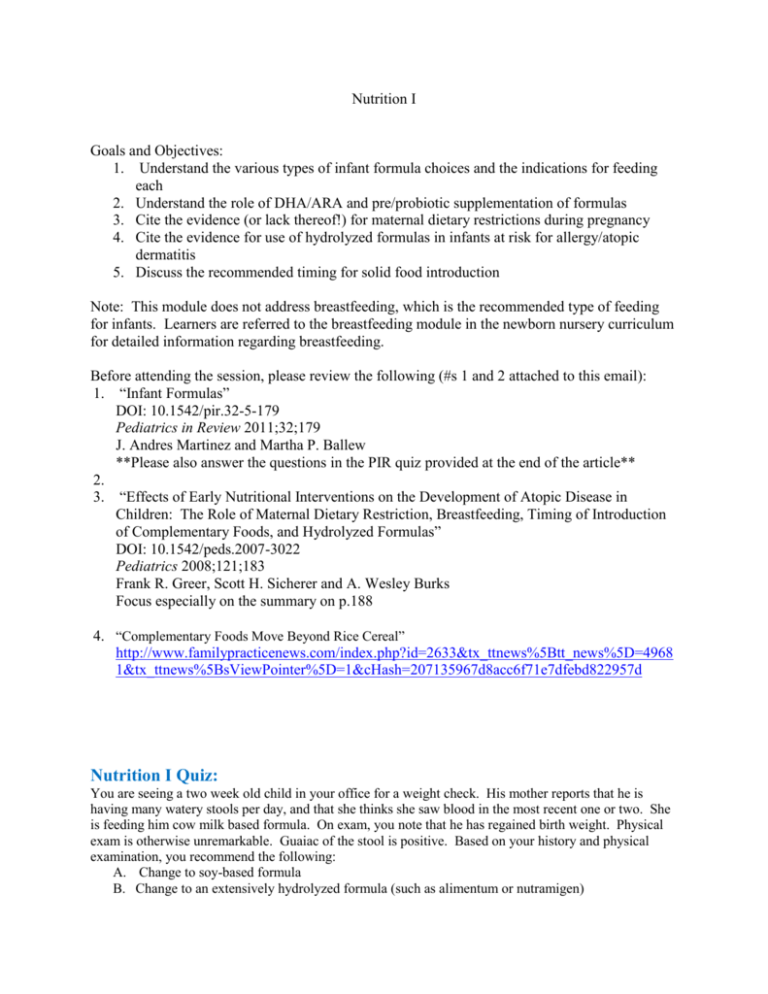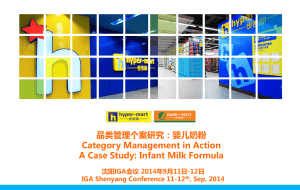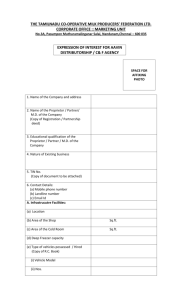Nutrition - Stony Brook University School of Medicine
advertisement

Nutrition I Goals and Objectives: 1. Understand the various types of infant formula choices and the indications for feeding each 2. Understand the role of DHA/ARA and pre/probiotic supplementation of formulas 3. Cite the evidence (or lack thereof!) for maternal dietary restrictions during pregnancy 4. Cite the evidence for use of hydrolyzed formulas in infants at risk for allergy/atopic dermatitis 5. Discuss the recommended timing for solid food introduction Note: This module does not address breastfeeding, which is the recommended type of feeding for infants. Learners are referred to the breastfeeding module in the newborn nursery curriculum for detailed information regarding breastfeeding. Before attending the session, please review the following (#s 1 and 2 attached to this email): 1. “Infant Formulas” DOI: 10.1542/pir.32-5-179 Pediatrics in Review 2011;32;179 J. Andres Martinez and Martha P. Ballew **Please also answer the questions in the PIR quiz provided at the end of the article** 2. 3. “Effects of Early Nutritional Interventions on the Development of Atopic Disease in Children: The Role of Maternal Dietary Restriction, Breastfeeding, Timing of Introduction of Complementary Foods, and Hydrolyzed Formulas” DOI: 10.1542/peds.2007-3022 Pediatrics 2008;121;183 Frank R. Greer, Scott H. Sicherer and A. Wesley Burks Focus especially on the summary on p.188 4. “Complementary Foods Move Beyond Rice Cereal” http://www.familypracticenews.com/index.php?id=2633&tx_ttnews%5Btt_news%5D=4968 1&tx_ttnews%5BsViewPointer%5D=1&cHash=207135967d8acc6f71e7dfebd822957d Nutrition I Quiz: You are seeing a two week old child in your office for a weight check. His mother reports that he is having many watery stools per day, and that she thinks she saw blood in the most recent one or two. She is feeding him cow milk based formula. On exam, you note that he has regained birth weight. Physical exam is otherwise unremarkable. Guaiac of the stool is positive. Based on your history and physical examination, you recommend the following: A. Change to soy-based formula B. Change to an extensively hydrolyzed formula (such as alimentum or nutramigen) C. Change to an amino-acid-based formula (such as neocate or elecare) D. Continue current formula E. Refer to gastroenterology The same infant returns for his one month well check. The mother reports that his stools are less frequent and there is no more blood. She asks you if her son will be allergic to milk for the rest of his life. You respond: A. He will likely outgrow his milk allergy by six months of age B. He may outgrow his milk allergy by age one, and can try cow’s milk at that time C. He will likely out grow his milk allergy, but will always be sensitive to lactose D. He is unlikely to ever outgrow his milk allergy The same infant returns for his fifteen month well check and is tolerating milk products well. The mother reports that she is expecting another baby and would like to “do something” while she is pregnant to prevent the occurrence of milk allergy in her next baby. Of the following choices, your best response is: A. She should avoid milk, eggs, and peanuts while pregnant, but may eat them during breastfeeding. B. She should avoid milk, eggs, and peanuts while pregnant and lactating. C. She should avoid milk only while pregnant and lactating D. She may continue her normal diet while pregnant and lactating E. She may continue her normal diet while pregnant, but should restrict milk while lactating. Then mom returns with her new infant for her first visit. She wants to know what formula to feed her new infant to help prevent milk allergy. After discussing the protective effect of exclusive breastfeeding in the first four months of life in helping reduce the risk of milk allergy, you reply: A. There is some evidence that partially or extensively hydrolyzed formulas may prevent the development of milk allergy in those at risk. B. There is some evidence that soy formula may prevent the development of milk allergy in those at risk. C. There is some evidence that late (after age 6 months) introduction of solid foods may prevent the development of milk allergy in those at risk. D. Introduction of fish, eggs, and peanuts should be delayed until after age 1. Nutrition I Board Review: 1. During a routine health supervision visit, the mother of a 2½ month-old male infant tells you that the baby has been experiencing bloating and flatulence. His diet consists of 5 to 6 oz of a cow milk-based formula given five times per 24 hours. Because of frequent spitting-up, his mother recently added rice cereal to each bottle. He has two to three seedy stools per day. On physical examination, the baby is alert and vigorous. His length and weight are tracking between the 50th and 75th percentiles. The infant’s mother asks you whether switching to a soy protein-based formula will help her baby’s "gassiness." Of the following, the MOST likely the cause of this infant’s symptoms is A. cow milk protein allergy B. excessive energy intake C. incomplete starch digestion D. lactose malabsorption E. sucrase-isomaltase deficiency 2. You are addressing a group of new mothers regarding infant feeding. One asks you when an infant can be switched from formula to whole cow milk. Of the following, you are MOST likely to respond that whole cow milk A. can be introduced at 6 months of age if an infant has significant gastroesophageal reflux B. can be given at 9 months of age if the infant is also taking a wide variety of supplemental foods C. may be given as a supplement at any age as long as the infant also receives human milk D. should be avoided until 12 months of age because its iron content is absorbed poorly E. should be avoided until 2 years of age because its caloric content is inadequate for optimal growth







